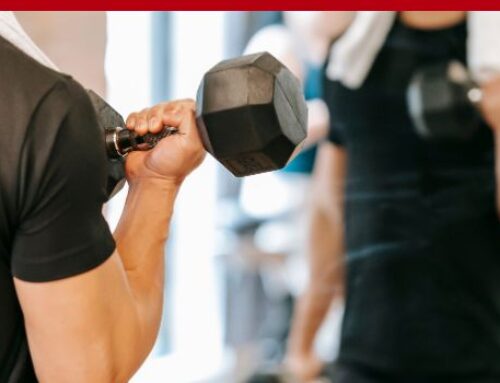
272: FREE Training Series: Everything You Need To Know About Building Muscle In Your 40s with Ted Ryce
Part 1: Why you want to focus on building lean muscle in your 40s, 50s and 60s
So you want to build muscle and strength…
Maybe you’re a former athlete who’s gotten out of shape as you’ve progressed in your career and you’re looking to make a change.
Maybe you were never in shape and you’re looking to get started now.
Or maybe you’re a woman who’s finally figured out that lifting weights is the key to getting the healthy, toned body you long for.
If that’s you, you should keep reading this article. This might be the most important article that you read about how to build muscle in your 40s, 50s, and beyond.
Why?
Because in this article I focus on what I consider the most important aspects of strength and muscle building for people who don’t have the easy lifestyle and surging hormone levels of people in their 20s.
In other words, for people who probably have more “stuff” going on in their life than they did at 21, making it difficult to focus on eating right and training regularly.
And the enthusiasm you once had for exercise—especially if you haven’t seen the results you were hoping for—may have waned, too.
But none of this matters. With the right type of training, you can still build muscle and get strong well into your forties, fifties, and beyond.
No matter who you are, or why you want to build muscle, I want to help you achieve your fitness goal.
I’ve been obsessed with building muscle ever since I was in high school.
Watching Arnold Schwarzenegger and Bruce Lee movies inspired me to explore the performance limits of most amazing piece of machinery in the world—the human body.
Perhaps the most incredible aspect of the human body is its ability to adapt to almost any challenge or stress it encounters.
The curious thing is that the body doesn’t like to change. Under normal circumstances, it works to maintain a state of balance known as homeostasis.
Only by stressing the body do we force it to change and adapt. Growing muscle is no exception to this rule.
By stressing your muscles in a progressive way and allowing them adequate recovery, you will you be able to build strong muscles that will keep you healthy and active for the rest of your life.
In this 4-part series article, you’ll learn:
- The different types of muscle fibers
- Why building muscle is important for your health (and not just to look great naked)
- The 3 stressors that cause muscle growth
- How many reps and sets you should do
- A sample workout to try out this week
- How much protein you should eat to build muscle
- Why rest and recovery are key to growing muscle
Why do I need to learn all of that?
Because you need knowledge. From how muscle works to what it takes to build a lean, athletic human body, these articles are packed with guidance and science. All you have to do is read and execute.
Let’s get started!
Note: The information in this article will benefit you regardless of your age.
(Looking for a workout that uses light weights but builds strength, too? Check out the Legendary Muscle Program.)

The Two Types Of Muscle Fibers
What do you know about muscle?
Muscles are actually a bundle long strands of cells (called muscle fibers) sheathed in connective tissue.
The structure and function of muscles is quite complicated—just open up any human physiology textbook.
The most important thing is that you need all of your 650 muscles in working order to perform the normal functions of everyday life—eating, breathing, walking, holding in your stomach at the beach.
Granted, you don’t need to spend a lot of time thinking about most of your muscles. But we’ll go over a few things so you understand the basics.
Type I
Type I muscle fibers, also called “slow-twitch” muscle fibers, are your endurance muscle fibers. These are the muscle fibers that take over during exercise that last more than a few minutes.
They are red in color due to the presence of large volumes of myoglobin and also have high numbers of mitochondria. They are very resistant to fatigue but also have the least potential for growth and strength.
Type II
Type II fibers, also called “fast-twitch” muscle fibers, have the greatest potential for growth and strength. However, they aren’t great for endurance because they fatigue much faster than Type I fibers.
I won’t go into detain but there are two types of fast-twitch muscle fibers: Type IIa and Type IIx (historically called IIb).
There’s a lot of talk on the interwebz about training for your muscle fiber type. There’s even a company that will do a DNA test to determine your what type of muscle fibers you have more of then give you training recommendations based on the results.
The reality is most of the muscles in your body have a fairly even split between fast-twitch and slow-twitch muscle fibers and the idea that special training methods target specific muscle fiber types doesn’t have strong evidence.
Related Post: 11 Ways To Upgrade Your Fitness, Boost Your Motivation, And Change Your Lifestyle
On top of that, even if you did have a dominant fiber type in your muscles, I don’t think it would change the advice to train muscles in a variety of rep ranges.
I dive into this exact conversation with Dr. Andy Galpin, who is a Professor of Kinesiology at the Center for Sport Performance at California State University, Fullerton.
He is the founder and director of the Biochemistry and Molecular Exercise Laboratory and researches this very topic as well as many others.
Muscle Satellite Cells
There are something called satellite cells in muscles. You can think of them as pre-muscle cells. They lay dormant in your muscles until you activate them with strenuous exercise.
Once they’re in action, they provide the necessary material for muscle growth and repair.
A 2008 study from the University of Alabama highlights how important satellite cells are to muscle growth.
For the study, researchers recruited a few dozen people who hadn’t lifted weights in the past 5 years, then put them all on the same workout program for 16 weeks to see what would happen.
The results?
The researchers found that the study’s subjects fit into three categories:
- Extreme responders. These people got a whopping 50 percent increase in their thigh muscles in 16 weeks.
- Moderate responders. These people increased their thigh muscle size by 25 percent in 16 weeks.
- Low responders. These people’s thigh muscles didn’t grow at all in 16 weeks.
The researchers also found the results were predictable.
The people who gained the most muscle mass started off with the most satellite cells. As I’ve already mentioned, satellite cells help muscle fibers grow and repair.
The more you have, the bigger you can grow. Some people have a lot. Most of us have a moderate amount.
And, unfortunately, some of us are born with very little.
With all the tools we have to manipulate diet and training programs, and all the ways that lifestyle choices affect your physique, it’s hard to believe that genes play such an outsized role in the results.
We can accept that genetics determine our height and hairlines. But our muscles?
Unfortunately, it’s true. It does affect our gains. But I’m a huge believer that we should work with what we have in our favor, not focusing on what is working against us.
Because at the end of the day, getting in shape in the modern world is a “war” that we need to fight every day.
So if you’re not getting the results you want, you better pay extra attention to this article.

Why You Should Care About Building Muscle
This is a great question.
Most people who are interested in building muscle start out because they want to look great naked. And there’s nothing wrong with that at all.
In fact, performing workouts that build muscle can help you change your body into a leaner, stronger and more defined (and sexier) version of yourself.
Following a workout program that is specifically designed [like my Legendary Muscle Workout] to build muscle is one of the fastest way to transform your body—even if you don’t follow a fat loss diet.
Exercise isn’t just about improving your esthetics today. Every minute spent in the gym fortifies your body against potential ailments far in the future.
This is something that the 20-year-old Instagram fitness gurus won’t tell you.

We Lose Muscle As We Age
Have you ever seen someone, usually in their 40s or older, using the hand rail to climb stairs because they’re unsure if their legs have the strength to get them to the next step on their own?
You were most likely witnessing sarcopenia in action.
Sarcopenia has been defined as an age related, involuntary loss of skeletal muscle mass and strength.
It can begin as early as 40 and continues to progress as you get older. Some people lose up to 50% of their muscle mass by the time they reach their 80s.
While there’s no single cause of sarcopenia, decline in activity, poor nutrition (especially inadequate protein), systemic inflammation, chronic illness, neurological decline and hormonal changes are all contributing factors.
Besides not being able to do the things you want to, sarcopenia is also associated with acute and chronic disease states, fatigue, falls, and mortality.
It sets you up for a life of dependence on others, illness, and regular hospital visits.
This not only costs you money but your quality of life as well.
And if you’re listening to the podcast for a while I guess you don’t want to spend your hard-earned money on doctor’s bills and become dependent on others to do the basics…like getting up out of a chair.
The goal here is to improve your body and health and live a Legendary Life.
With sarcopenia, your muscles decrease in size and number. An interesting fact is that your Type II muscle fibers are the ones most affected.
And your satellite cells are involved as well. In the muscle of older adults, the satellite cell content is reduced and is more pronounced in the Type II muscle fibers.
You may not be able to stop aging, but you can certainly exercise, eat better, and avoid excessive inflammation.
In fact, it’s been suggested that a lack of physical activity is the greatest cause of sarcopenia.
That’s something you can remedy starting immediately with a set of bodyweight squats and push-ups.
Stop reading and do it now. When you finish, this article will be waiting for you afterward. J
It’s also important to get adequate protein (we’ll get into how much later in this article).
Those are two things you have a lot of control over.
As you can see, maintaining strength and muscle as you age is critical to your metabolic health and physical abilities.

We Lose Strength As We Age
More recently, scientists have been talking about dynapenia—which is the age-associated loss of muscle strength that is not caused by neurologic or muscular diseases.
Although we typically think of bigger muscles as stronger muscles, this is not necessarily the case.
Recent findings have clearly demonstrated that muscle size plays a relatively minor role in developing dynapenia.
How serious is dynapenia?
I’ve told the story of watching a relatively healthy, older man who was barely able to climb into the cockpit of the plane ride I took through the Grand Canyon.
It took him a couple of minutes and all of his upper body strength to finally get into the front seat of the small plane we flew in.
I’ve also told the story of an older CEO I trained who rode the exercise bike every week but barely had the strength to get in and out of his Porsche 911.
Aerobic exercise is important but maintaining function is even more important.
Remember, sarcopenia and dynapenia affect your type II muscle fibers much more than your type I muscle fibers.
Aerobic exercise predominantly works your type-I muscle fibers.
Are you getting sad because aging sucks?
Don’t be. I just turned 40 and I’m all about testing every technique available in the market to see what really works to stay in shape in your 40s and improve your health and quality of life so you age well.
Most of the issues we attribute to age actually come from not taking proper care of our bodies.
I’m about to tell in this article series all the doable, easy and natural ways you can prevent, decrease and even reverse (or at least slow down) undesirable sarcopenia.
So, keep reading.
Just a quick tip, if you’re time-limited, to do a resistance training workout instead of an aerobic workout.
You can always add in some aerobic exercise later. But if you lose your strength, doing aerobic exercise is going to be very difficult.
Listen Part 2: 6 Smart Ways to Build Muscle Faster
Listen Part 3: How Protein Helps Increase Muscle Size and Strength (And How Much Protein Should You Eat To Build A Muscular Body)
Listen Part 4: How To Speed Up Muscle Recovery In 4 Simple Steps
Similar Episodes you may like
About the Show
The Legendary Life is a fun and enlightening look at health fitness, nutrition, biohacking, fat loss, anti-aging, and cutting-edge health advice from celebrity fitness trainer Ted Ryce. Ted’s clientele consists of celebrities, including Richard Branson, Ricky Martin, and Robert Downey Jr., CEOs of multimillion-dollar companies, and other high performers.
He breaks down countless health topics and provides science-backed solutions and the most effective, uncommon strategies to rapidly lose weight, improve your health, and upgrade your physical and mental performance, so you can live the life you deserve.
He breaks it down by providing science-based information so you can clear up the confusion and finally lose weight, fight disease, and live a longer, healthier life.
No guru. No fluff. And no preaching of generic fitness advice here. Along the way, Ted shares his own journey of how he turned great tragedy and loss into success and hope.
Now, his mission is to empower you with the tools and the knowledge you need to live your best life. New episodes every Monday and Friday.






